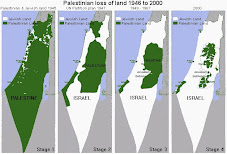At least 15 tombstones and structures were torn apart Wednesday in the Mamilla (Ma'man Allah) cemetery, the Al-Aqsa Foundation for Waqf and Heritage said. The latest demolitions follow the disinterment of over 1,500 graves in 2009 to make way for a controversial Museum of Tolerance. The foundation quickly denounced the move, describing it as a "heinous crime."
Mandated with renovating burial grounds, the foundation said its crew led by Fawaz Hassan and Mustafa Abu Zuhra tried to block the bulldozers with their bodies but were removed by police. Israeli authorities razed the tombstones in the northeastern part of the cemetery, despite the crew's objection, and left an hour after.
A spokesman for Israel's national police did not return multiple calls seeking comment, but the Jerusalem municipality said in a statement that it had "located illegal activity at the site," filed a complaint with police, and "turned to the Israel Land Administration, who owns the land, to restore [it] to its prior condition. The ILA cleared the vacant tombstones, which were built illegally with the aim to take over the plot."
Dating back 1,000 years, the Mamilla cemetery was an active burial ground until 1948, when West Jerusalem became part of the newly declared State of Israel. According to Muslim tradition, it is the burial site of the Prophet Mohammad's companions, Salah Ad-Din's warriors, Sufi saints, as well as judges, scholars, and Palestinian dignitaries.
Plans for the museum, funded by the Simon Wisenthal Center, a Jewish charity in the US, were unveiled in 2004 and sparked immediate controversy. Palestinian descendants with relatives buried at the site have launched a lengthy legal and public relations battle in a bid to stay the museum's construction. In 2008, however, they lost a case before Israel's High Court, which ruled in favor of the museum.
One descendant is US academic Rashid Khalidi, the Edward Said Professor of Arab Studies at Columbia University. He told Ma'an that "If it is true that further graves in the Mamilla cemetery have in fact been bulldozed, then clearly the ongoing process of desecration of this sacred space has not been halted by the efforts of the families of those interred there to bring this issue before a variety of international forums."
"As far as the Israeli authorities are concerned, some graves merit respect, and some do not. Those of our ancestors in this cemetery, going back in some cases for many hundreds of years, obviously do not."
In February, Mamilla descendants filed a petition with the UN, later submitting evidence compiled by the Israeli daily Haaretz, which revealed in a three-part expose the extent of disinterment, publishing photographs of remains being stuffed haphazardly into cardboard boxes. The families of those buried at the site say the Israeli government has yet to inform them of the location of their relatives' remains.
Gideon Sulimani, an archeologist with Israel's Antiquities Authority who carried out the initial digs in 2009, told the newspaper at the time: "They call this an archaeological excavation but it’s really a clearing-out, an erasure of the Muslim past. It is actually Jews against Arabs."
In June, Nazareth-based journalist Jonathan Cook revealed that a second dig was in the works, with Israel planning a courthouse on the historic site. At least three tombstones were removed that same month.
Most of the graves are unrecognisable and in disrepair, owing to decades of neglect. Descendants of those buried there say personal attempts to replace or maintain tombstones have been repeatedly quashed and swiftly removed by Israeli authorities. The Al-Aqsa Foundation's renovation crew says the municipality regularly thwarts their attempts to maintain the site.
The municipality says it "will not allow extremist elements to act illegally to change the status quo."







